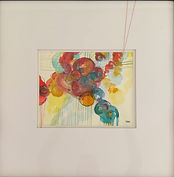
The Art of Becoming
The pieces featured in this exhibition emerged through exploration and experimentation with watercolor as a medium, which in its essence is both fluid and decisive, leaving little room for correction or alteration once the paint has dried.
Inspired by artists like Miro, Kandinsky, and Morrisseau, the collection examines change at the cellular level and its relationship to intellectual notions of identity. As such, watercolor is an ideal medium with which to imagine the hidden, sometimes invisible, qualities of biological processes like pregnancy and miscarriage, and concepts like microchimerism and ghost DNA.
Further, threads sewn into the paintings represent ancestral “knowing” passed across generations, as well as the physical connections between beings. Offering a biological analog to the oral tradition in the form of cellular storytelling, the threads originate from and travel beyond the bounds of the human-as-incubator, to support the notion of (epi)-genetic signatures that inform not one, but many paths from past to present into the future.
Group 1
microchimerism
(watercolor, ink, fiber/thread, 4x6 paper)
Scientists have adopted the mythical chimera to reflect the discovery of unique, free-floating DNA that is not the same as the host’s genetic profile, a biological concept called “microchimerism.”
This series of six small works presents an abstraction of cellular diagrams. They visualize the granular dynamics of pregnancy and miscarriage in human biological females, interrogating the ways in which cellular-level debris remains in the host even years later, both physically as free-floating DNA, and as psychic memory. These paintings offer an illustrative accompaniment to my poem of the same name.






Group 2
Cellular Blooms
(watercolor, ink, charcoal, fiber/thread, paper, 12x12)
The three larger square pieces in this exhibition offer an interpretation of cellular change, imagining dynamic movement in biological processes and considering genetic transmissibility in the form of cellular “blooms” that vacillate between overlapping elements and clearly defined boundaries; tightly formed visual constructs and expansive bursts of color and line.



Group 3
Ghost DNA
(watercolor, ink, fishing line, paper)
The two remaining small paintings reflect on DNA, discovered within modern populations, from an extinct type of human for which no fossil record exists. Metaphorically, this unknown ancestral group conjures all the ways our genealogical predecessors are strangers to us, yet somehow still influential via invisible attachments; and the ways our bodies can “know” more at the cellular level than we intellectually understand about ourselves.